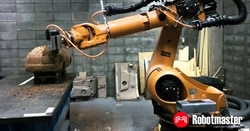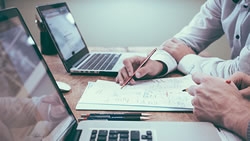Robotic programming brings increased productivity and faster return on investment
"By optimizing robot programs, users can see a significant increase in productivity while generating more profit with their robot, using robots for short production runs, and delivering closest conformance to design." Carlos Marcovici, Robotmaster Authorized Partner, Brazil
10 things to consider when exploring Offline Robot Programming software solutions
Offline Robot Programming (OLP) takes the programming "offline" - away from the teach pendent / robot cell - allowing the user to generate the robotic code from their computer without having to take the robot out of production to generate it.
How to Successfully Automate Packaging in Low-volume, High-mix Production
Recent advances in robotic programming have reduced the implementation time of robotic automation to a point where even small and medium sized manufacturers with high-mix, low-volume production can get a robotic packaging application up and running in just a few hours
Have You Looked at Automating Fabrication Tasks in the Past? Why Didn't You?
We recently hosted a webinar titled: Unlock Value-Stream Productivity with Robotic Cutting. During this webinar, we polled audience members. Our first question: Have you looked at automating fabrication tasks in the past. Most respondents said yes.
Big Trends in Offline Programming Software for Robot
In the world of robotics, Offline Programming (OLP) has come a long way in a short time, and the global pandemic has jumpstarted more innovation. Industrial robots have evolved to collaborative robots ("cobots") that work side by side with their human counterparts.
Offline Robot Programming for Polishing Aircraft Engine Lipskins
In 2020, McStarlite invested in automation by integrating a KUKA robot coupled with Robotmaster offline robot programming (OLP) software, to perform the lipskin polishing application.
10 Things to Consider When Exploring Offline Robot Programming Software Solutions
Offline Robot Programming (OLP) takes the programming "offline" - away from the teach pendent / robot cell - allowing the user to generate the robotic code from their computer without having to take the robot out of production to generate it.
Calculating the ROI of Offline Robot Programming Software
Capital investments in advanced manufacturing environments require careful consideration, especially if that investment is for a new process or technology. If you are looking at"¯investing in OLP here are some things to consider about the potential return on investment (ROI).
Is your OLRP Implementation Process SMART?
For any Offline Robot Programming solution to be effective, the virtual robot cell set up in the software must be identical to the existing physical robot cell. OCTOPUZ refers to this process as "implementation".
Records 1 to 9 of 9
Featured Product

Elmo Motion Control - The Platinum Line, a new era in servo control
Significantly enhanced servo performance, higher EtherCAT networking precision, richer servo operation capabilities, more feedback options, and certified smart Functional Safety. Elmo's industry-leading Platinum line of servo drives provides faster and more enhanced servo performance with wider bandwidth, higher resolutions, and advanced control for better results. Platinum drives offer precise EtherCAT networking, faster cycling, high synchronization, negligible jitters, and near-zero latency. They are fully synchronized to the servo loops and feature-rich feedback support, up to three feedbacks simultaneously (with two absolute encoders working simultaneously). The Platinum Line includes one of the world's smallest Functional Safety, and FSoE-certified servo drives with unique SIL capabilities.
Robotics and Automation - Featured Company

KNF Neuberger, Inc.
We are KNF. Founded in 1946 in Freiburg im Breisgau, Germany, we are a family-owned manufacturer that has established itself as a global solution provider specializing in the development, design, production and distribution of diaphragm pumps for the transfer of gases and liquids or for vacuum generation. With 24 locations and over 900 employees worldwide, we continue to expand our industry expertise and broad range of applications, including medical technology, inkjet, gas analysis and laboratory.





.png)



